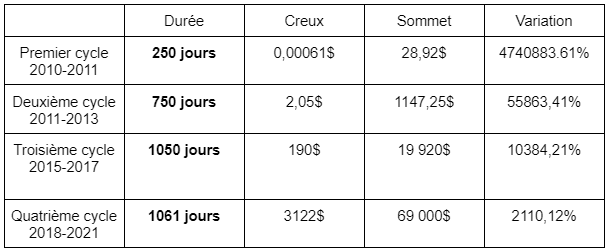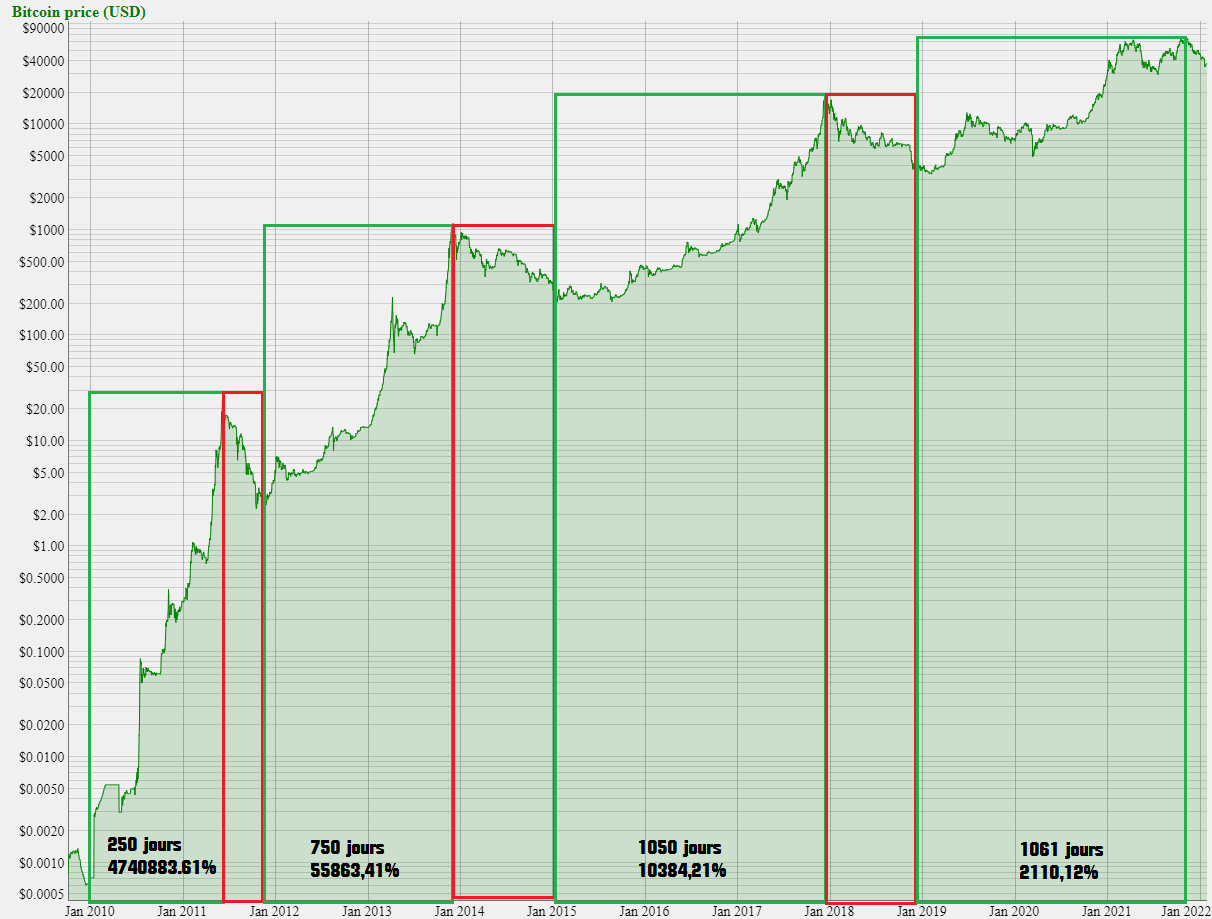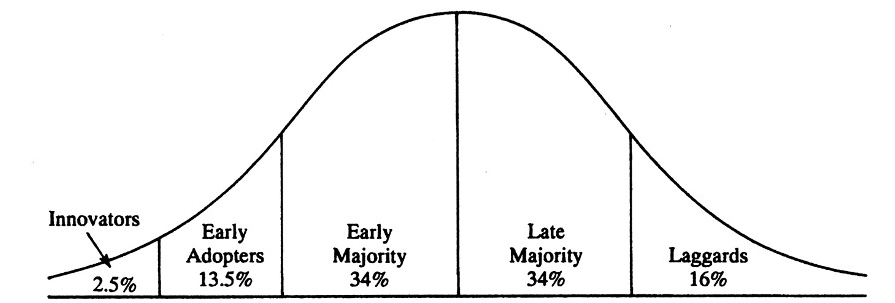One of the many unique features of Bitcoin is its process of halving the BTC reward passed to miners (here is my article dedicated to this BTC halving : Bitcoin mining and halving day: Let’s dig into the subject). This process, called “halving day”, has always been followed by a large bullish movement and preceded by a bearish consolidation.
Halving day chart
Source: bitcoin.fr
To put it simply and briefly, the halving day is an event that occurs once every four years (i.e. every 210,000 blocks on Bitcoin) that halves the reward to miners for validating a block on the network. After the last reduction which took place on May 11, 2020, the reward is now 6.25 BTC per validated block. It is awarded to the first miner who solves a mathematical algorithm and deciphers the hash (mathematical function which makes it possible to close a block and thus move on to the next).
The halving days have been a way in the past to measure cycles not from an absolute minimum, but from a supply and demand perspective. It is clear that by studying the graph above, the process of halving day has always been followed by a stratospheric bullish movement. Will this trend continue? ad vitam aeternam ? Let’s take a look at a computational model that has proven to be terrifically effective so far.
Stock-to-Flow (S2F)
In 2019, a former Dutch professional investor, PlanB, published an article title : “Modeling Bitcoin Value with Scarcity”. It presents how we can quantify the scarcity and value of bitcoin.
Quite simply, the Stock-to-Flow (S2F) model represents the ratio between the stock of an asset and its annual production. We could use it for various precious metals having a limited amount of predefined resources. Yes, because as a reminder, the number of bitcoins mined is limited by the Bitcoin code to 21 million units. At present almost 19 million bitcoins have been mined, but with the halving day which reduces the daily production of BTC, the last mined bitcoin is scheduled for 2140. In other words, few of us will be there to see it… Back to our model.
To study the value of bitcoin through the prism of its scarcity, Plan B integrated the different halvings and therefore the amount of bitcoins mined over time. What is striking is that the S2F model highlights price areas where bitcoin is considered under or overvalued based on Stock-to-Flow (i.e. based on bitcoin production) and if we look taking a closer look, we notice at a glance that bitcoin price peaks and troughs are, historically, relatively well correlated with the halving day.(in the graph below, the transition from blue to red indicates the day of the halving day).
Stock-to-Flow
Source: stats.buybitcoinworldwide
You are not dreaming, according to his model, the price of bitcoin should reach more than 1 million dollars in 2026. If scarcity is the fundamental pillar of the model, it is obviously not the only factor to determine the value of bitcoin. The regulations, the news, the enthusiasm of institutional investors, the arrival of private and professional investors, the internet coverage rate, the mining conditions or the installation of bitcoin vending machines (ATM BTC) among others, are in fact, there are so many variables that can positively or negatively influence demand. If we enter a bearish cycle, as bitcoin has experienced before, the S2F would have failed for the first time. Indeed the price would not have progressed proportionally to its rarity on this cycle.
As a crypto investor or just an observer, we are inevitably attached to the intrinsic reactions that these sudden shifts in market sentiment can bring. However, in times of volatility, it is crucial not to lose sight and remember the following adage “if in doubt, zoom out”.
Bitcoin is still by far the best performing asset of the past decade and its value proposition remains fundamentally unchanged. On the other hand, we can observe that the cycles, materialized by an absolute trough in the price and a historical peak, tend to lengthen, which increasingly calls into question the Stock-to-Flow and therefore the supercycles that the digital gold experienced.
Bitcoin Supercycles
Bitcoin’s cycle lengthening hypothesis assumes that each successive cycle lasts longer. By measuring the performance and the number of days between the absolute low of the price to the absolute high of the price of BTC, we can see this.
For example :
The current cycle, which started with a low at $3122 on December 15, 2018, has reached a longevity of 1061 days if it is estimated that the price peak was reached last November 10 at $69,000. The cycle could possibly lengthen. But what about the past?

bitcoin cycles
The cycles are getting longer and longer with performance “less and less stratospheric.”

These increasingly longer periodicities between lows and highs coincide with the “elongation cycle” theory popularized by Benjamin Cowen, renowned crypto analyst and founder of Into The Cryptoverse . Overall, this theory suggests that Bitcoin’s market cycles are getting longer while producing diminishing returns. As unbelievable as it may seem today, this implies that Bitcoin’s volatility will trend more and more towards 0 in 10 to 15 years. For Bitcoin to remain consistent with the elongation cycle theory, it needs to experience even more massive adoption before stabilizing. This hypothesis leads us naturally to Everett Roger’s theory of the diffusion of innovation.
The Diffusion of Innovation Theory
If we look at Everett Roger’s innovation adoption theory, the diffusion of a disruptive innovation strongly depends on its human capital component. Within this framework, the percentage of customers who adopt a disruptive innovation over time can be divided into 5 distinct categories:

Everett Roger’s Diffusion of Innovation Theory
Innovators (2.5%), Early Adopters (13.5%), Early Majority (34%), Late Majority (34%) and Laggards (16%). According to many experts, the adoption of crypto assets is approaching the end of the early adoption phase as it tests entry into the early majority phase.
As adoption moves along the curve, volatility decreases, creating potentially more stable bitcoin over time. It will likely take decades for the asset to fully stabilize. As Bitcoin’s market capitalization increases, and so does liquidity, volatility should naturally continue to decline.
If we go back to Benjamin Cowen, he believes that the reason for the lengthening of the cycles is the increased inflow of silver from different parts of the globe. Countries like India, El Salvador or Vietnam among others, have become huge centers of cryptography in 2021. This rise of government initiatives plays in favor of the growth of the digital currency.
Additionally, a number of celebrities have backed NFT projects and DeFi (decentralized finance) platforms and big companies like Mastercard, Microsoft, Expedia, Meta, PayPal and even Google have ventured into crypto territory to develop crypto-blockchain-nft solutions. Finally, with the support of Elon Musk and Michael Saylor, Bitcoin has seen an influx of billions of dollars. All these factors also have the effect of supporting bitcoin and by extension other crypto-active projects.
The typical four-year cycle that most analysts use to predict bitcoin price bulls and bears will most likely be replaced by a less volatile and less cyclical market. And as we’ve seen, the transition is in full swing with bitcoin flattening in both performance and cycles.
